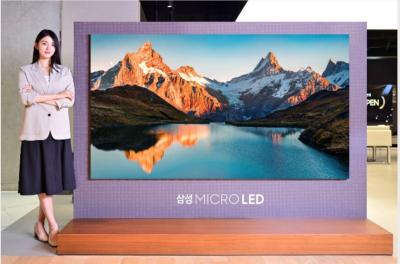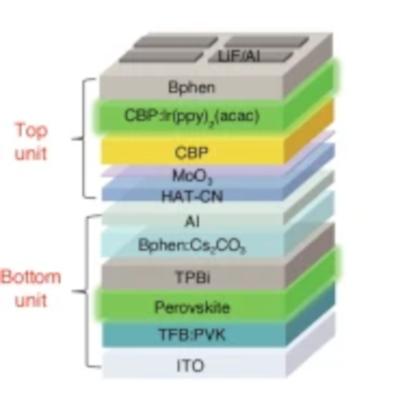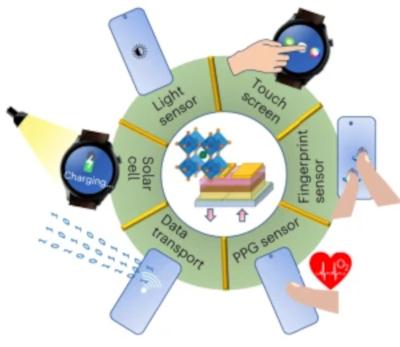Perovskite LEDs - recent news - Page 3
Researchers design efficient and stable hybrid perovskite-organic LEDs
Researchers at China's Shanghai University, Southern University of Science and Technology, The University of Hong Kong, Yunnan University, Beijing Institute of Technology and Japan's Yamagata University have developed a stable, efficient and high-color purity hybrid light-emitting diodes (LEDs) with a tandem structure, by combining perovskite LED and commercial organic LED technologies.
Device structure. Image credit: Light: Science & Applications
Perovskite-based LED technology can have tunable emission wavelength in visible light range as well as narrow linewidth, which makes it a promising contender among current light-emitting display technologies. However, it still suffers from severe instability driven by electric field. The research team in this work set out to tackle this challenge, by developing a method to create efficient and stable hybrid perovskite-organic light-emitting diodes.
Researchers create full-color fiber light-emitting diodes based on perovskite quantum wires
Researchers from the Hong Kong University of Science and Technology, Sun Yat-sen University and Nanjing University of Science and Technology have uniformly grown all-inorganic perovskite quantum wire arrays by filling high-density alumina nanopores on the surface of Al fibers with a dip-coating process.
Fiber light-emitting diodes (Fi-LEDs), which can be used for wearable lighting and display devices, could be a key component for fiber/textile electronics. However, as a number of challenges exist with this technology, researchers are trying to address issues like on device fabrication with fiber-like substrates, as well as on device encapsulation.
Researchers develop perovskite/organic tandem device for dual light detection and emission functions
Researchers at China's Nanjing University of Science and Technology, Hong Kong Baptist University and Southwest University have introduced a tandem device that incorporates an organic photodiode (OPD) and a perovskite light emitting diode (PeLED), enabling simultaneous light detection and emission in one compact device, prepared by all-solution fabrication process.
The team found that precise control of interfacial properties plays a critical role in establishing the all-solution processed OPD/PeLED multi-layered dual-function device which is critical for charge transport, recombination, and generation.
Researchers develop high-efficiency pure red light-emitting diodes through surface modification of perovskite QDs
Researchers from Korea's Daegu Gyeongbuk Institute of Science and Technology (DGIST), Ulsan National Institute of Science and Technology (UNIST) and Institute for Basic Science (IBS) recently developed high-performance, skin-attachable perovskite pure red light-emitting devices to create various forms of wearable displays.
The team developed these devices through selective surface modification of perovskite quantum dots, expecting their future use in diverse wearable products. As traditional red perovskite materials were unsuitable for high-performance wearable displays due to their low stability and electrical properties, the research team created pure red light-emitting devices through the simple surface modification of the perovskite light-emitting layers, thus significantly improving their stability and electrical properties.
Perovskites’ bright future in the MicroLED industry
Micro-LED (also known as mLED or µLED) is a display technology based on miniature LED devices that are used to directly create color pixels. Micro-LED displays are highly promising and have the potential to create efficient and great looking flexible displays, which could challenge even the most impressive high-end OLED displays. Micro LEDs are attracting significant attention as next-generation displays owing to their desirable characteristics such as low power consumption, high contrast ratio, high brightness, fast response speed, and long life span.

Perovskite materials can benefit the MicroLED industry in two ways: as materials for color conversion (using perovskite-based QDs) and in perovskite-based LED emitters. Much R&D work is taking place on both these fronts, and interest seems to be growing.
Researchers design multifunctional display based on photo-responsive perovskite light-emitting diodes
Researchers at Linköping University, Nanjing University and NanjingTech have developed a multifunctional display that uses photo-responsive metal halide perovskite LEDs as pixels. The perovskite LED display can be simultaneously used as a touch screen, ambient light sensor and image sensor (including for fingerprint drawing) without integrating any additional sensors. The light-to-electricity conversion efficiency of the pixels also allow the display to act as a photovoltaic device that can charge the equipment.
Illustration of functions realized by the multifunctional display. Image from Nature Electronics
This is a step forward compared to current display screens, which are typically only used for information display, but can have a range of different sensors integrated into them for functions such as touch control, ambient light sensing and fingerprint sensing. According to the team, photo-responsive light-emitting diodes (LEDs), which can display information and respond to light excitation, could be used to develop future ultra-thin and large screen-to-body ratio screens. However, photo-response is difficult to achieve with conventional display technologies.
Researchers develop "all-in-one" organic ligand for emitting perovskite nanocrystals
Perovskite nanocrystals (PNCs) have considerable potential as next-generation display materials thanks to their excellent photoluminescence quantum yield (PLQY), wide color gamut, and narrow emission bandwidth. However, due to their weak stability against solvents, their patterning remains a challenge. In a recent study, researchers at Ajou University, Hanyang University, Sungkyunkwan University, Macquarie University and Kongju National University developed functional organic ligands (AzL1-Th and AzL2-Th) for the fine pixelation of perovskite nanocrystal (PNC) displays.
Functional ligands containing photocurable azide moieties exhibit good charge transport properties and fast and efficient photocrosslinking performance, while maintaining a high PLQY. The team successfully demonstrated the crosslinked PNC light emitting diodes using AzL1-Th. The results suggest the high potential of photocurable ligands for the micro-patterning of PNC films without film damages.
Researchers develop method for enhancing the performance of blue perovskite LEDs
Researchers at the University of Cambridge, University of Science and Technology of China, Shanghai Jiao Tong University, Soochow University, OIST, Hong Kong University of Science and Technology, Victoria University of Wellington and Kyushu University have demonstrated efficient blue perovskite LEDs based on a mixed two-dimensional–three-dimensional perovskite and a multifunctional ionic additive that enables control over the reduced-dimensional phases, non-radiative recombination channels and spectral stability.
The team reported a series of devices that emit efficient electroluminescence from mixed bromide/chloride quasi-three-dimensional regions, with external quantum efficiencies of up to 21.4% (at a luminance of 22 cd m–2 and emission peak at 483 nm), 13.2% (at a luminance of 2.0 cd m–2 and emission peak at 474 nm) and 7.3% (at a luminance of 6 cd m–2 and emission peak at 464 nm). The devices showed a nearly 30-fold increase in operational stability compared with control LEDs, with a half-lifetime of 129 min at an initial luminance of 100 cd m–2.
Perovskite-Info launches a new edition of its Perovskite for Displays Market Report
Perovskite-Info is proud to announce an update to our Perovskite for the Display Industry Market Report. This market report, brought to you by the world's leading perovskite and OLED industry experts, is a comprehensive guide to next-generation perovskite-based solutions for the display industry that enable efficient, low cost and high-quality display devices. The report is now updated to February 2024, with all the latest commercial and research activity. This was a major version, with over 15 updates, new companies and new technologies covered.
Reading this report, you'll learn all about:
- Perovskite materials and their properties
- Perovskite applications in the display industry
- Perovskite QDs for color conversion
- Prominent perovskite display related research activities
The report also provides a list of perovskite display companies, datasheets and brochures of pQD film solutions, an introduction to perovskite materials and processes, an introduction to emerging display technologies and more.
Researchers develop new sieving technique for better perovskite LEDs
Researchers at the Chinese Academy of Sciences (CAS), University of Nottingham Ningbo China and University of Science and Technology of China have developed a novel solvent sieve method that significantly enhances the performance and operational stability of perovskite light-emitting diodes (PeLEDs).
Perovskites' practical application in PeLEDs has thus been constrained by their low operational stability. The recent research, centered on a comprehensive analysis of perovskite nanostructures, identified the presence of defective low n-phase perovskites as a primary factor undermining device stability. These defective phases, characterized by a minimal number of lead ion layers, arise from rapid and uncontrolled crystallization processes. The simple solvent sieve treatment reported in this study addresses this issue and improves the efficiency and stability potentials of high-brightness perovskite light-emitting diodes for future commercial applications.
Pagination
- Previous page
- Page 3
- Next page






